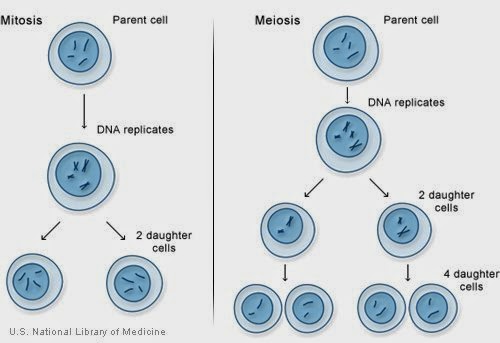Most cell undergoes division, ie, the formation of two daughter cells identical to the parent cell. This event occurs at the end of the cell cycle, which represents the set of modifications that must be met from the moment in which a cell is formed at the moment in which it divides into two daughter cells. The division is preceded by stages in which the cell doubles its intracellular content. Based on the ability to divide, cells are divided into three categories: ( a ) cells in continuous division, as the skin cells, which have a short life and must be replaced quickly; ( b ) stable cells, ie cells that after differentiation entering a phase of rest, from which they can return to the cycle if properly stimulated (eg., hepatocytes); ( c ) perennial cells, ie cells that after differentiation out permanently from the cycle (eg., neurons).
Conceive Plus
The rate of cell division is controlled by mechanisms partially known, that allow a cell to divide only if you need more cells. Numerous specific protein factors regulate the cell cycle, such as hormones and growth factors. The cell acts as a target, thanks to the presence of recognition systems of the stimulus to the division. Normally the number of cycles of replication is related inversely to the age of the animal from which the tissue was taken. For this reason, the cells derived from embryonic tissues can replicate in vitro for a longer time compared to cells isolated from tissues of adult organisms. The cells often lose the ability to divide after a certain period of time; this period is variable for the different cell types and to human cells is approximately 50 divisions. This was demonstrated in 1961 by Leonard Hayflick and Paul S. Moorhead, who observed that human fibroblasts died after a finite number of divisions in culture.
From healthy cell to the transformed cell
Some cells derived from multicellular organisms have a capacity of unlimited division in culture and can be used for the production of cell lines. The cell line is composed of transformed cells derived from tumor tissues or cells in primary culture have been changed as a result of spontaneous mutations or induced by exposure to viruses, chemical mutagens or radiation. Keep in mind that the transformed cells have many unusual characteristics that differentiate them from healthy cells. The alterations that occur as a result of processing related to the presence of a genetic aberrant, the reduction and the alteration of the cellular skeleton ( cytoskeleton ), modifications on the cell surface about the expression of antigens, the lower adhesiveness to the substrate and then the ' increased ability to proliferate in suspension and form multiple layers in the plate. Furthermore, the transformed cells have a lower dependence on the presence of serum in the culture medium and in some cases can produce tumors if they are injected into a suitable host organism.
In 1951, George O. Gey and his colleagues cultured the first human cell line, stabilized by a biopsy of the tumor tissue of the uterine cervix taken from a patient named Henrietta Lacks. The patient died shortly afterwards but his cancer cells were maintained in culture until today. These cells were called HeLa in their name and are currently used in many laboratories. We can obtain continuous cell lines through the introduction in normal cells of specific genes ( oncogenes ) by viral infection. If the tumor virus is added to the culture medium appear in a short time, small colonies of transformed cells that proliferate abnormally.






